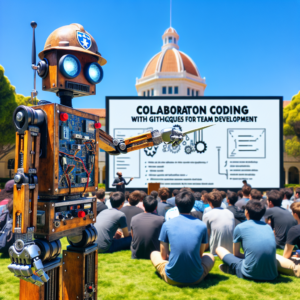1. Setting Up a GitHub Repository for Team Projects
When embarking on a collaborative coding project, the first step is to establish a central hub where all team members can access, review, and contribute to the codebase. GitHub serves as an ideal platform for this purpose, offering tools and features that facilitate effective GitHub team collaboration.
To start, create a new repository on GitHub. This repository will act as the primary storage for your project’s source code. Ensure that the repository settings are configured to manage team access effectively. You can do this by navigating to the ‘Settings’ tab of your repository, then to ‘Collaborate’. Here, you can add team members by their GitHub usernames and set appropriate roles for each, such as ‘Read’, ‘Write’, or ‘Admin’.
It’s crucial to structure your repository with a clear and consistent directory layout. This organization aids team members in navigating the codebase effortlessly. Include a README.md file at the root of your repository to provide an overview of the project, setup instructions, and other essential information that will assist collaborators in getting started smoothly.
Here’s a basic example of how to initialize a new repository and set up a README file using the command line:
# Initialize a new Git repository git init # Add a README file echo "# Project Title" >> README.md git add README.md git commit -m "Add initial README file" git remote add origin https://github.com/yourusername/yourrepository.git git push -u origin master
By following these steps, you establish a solid foundation for your team’s development work, ensuring that all members are aligned and can contribute effectively to the project. This setup not only enhances collaborative coding on GitHub but also streamlines the development process, making it easier to manage changes and track progress.
2. Best Practices for Collaborative Coding on GitHub
Effective collaborative coding on GitHub requires adherence to a set of best practices that streamline development and enhance productivity. These practices are essential for maintaining a clean and efficient workflow in a team environment.
Firstly, always use descriptive commit messages. This practice helps team members understand the changes made without needing to delve into the code. For example:
git commit -m "Refactor subroutine X for better performance"
Secondly, employ a consistent coding style and enforce it through the use of linters and formatters. This ensures that the codebase remains readable and accessible to all team members, regardless of their individual coding styles.
Another key practice is to utilize GitHub’s Pull Requests for any changes to be merged into the main branch. This allows for peer review, which not only improves code quality but also fosters knowledge sharing and reduces the chance of introducing errors. Here’s how you can create a pull request:
# Create a new branch git checkout -b new-feature # Make changes and commit git add . git commit -m "Add new feature" # Push the branch to GitHub git push origin new-feature # Go to GitHub and open a pull request
Additionally, integrate issue tracking with your coding tasks. By linking commits and pull requests to issues, you can provide context to your code changes and streamline the management of project milestones and bugs.
By following these best practices for GitHub team collaboration, your team can achieve more efficient and error-free coding sessions, leading to a more successful project outcome.
2.1. Managing Branches and Pull Requests
Effective management of branches and pull requests is crucial for collaborative coding on GitHub. This process helps maintain a clean and organized codebase, which is essential for any team project.
Branching is a core concept in Git. It allows you to diverge from the main line of development and continue to work independently without affecting others. Here’s a simple way to create a new branch:
git checkout -b feature-branch-name
Once you have completed your feature or fix, the next step is to merge it back into the main branch through a pull request. Pull requests let you tell others about changes you’ve pushed to a branch in a repository on GitHub. Once a pull request is opened, you can discuss and review the potential changes with collaborators and add follow-up commits before your changes are merged into the base branch.
Here are some best practices for managing pull requests:
– Keep pull requests small and focused to facilitate easier review and quicker integration.
– Link pull requests to issues to provide context and track project progress.
– Conduct thorough code reviews to ensure quality and consistency.
Here’s how you can open a pull request:
# Push your branch to GitHub git push origin feature-branch-name # Go to your repository on GitHub and click ‘Compare & pull request’
By adhering to these practices, you ensure that GitHub for teams is not just a repository hosting service but a powerful tool for collaborative development, enhancing both productivity and code quality.
2.2. Code Review Techniques for GitHub
Code reviews are a pivotal aspect of GitHub team collaboration, ensuring high-quality code and fostering team learning. Effective code review techniques can significantly enhance the collaborative coding experience on GitHub.
Start by setting clear code review guidelines. These should cover expectations for both the reviewer and the submitter, including how to write useful comments and how to respond to feedback. A good practice is to use GitHub’s inline commenting feature to pinpoint specific issues or suggest improvements directly within the code.
Here’s a simple guideline on how to perform a code review on GitHub:
# Review the 'Files changed' tab in the pull request # Click on a line of code to add a comment
Ensure that reviews are thorough but respectful. Focus on the code’s functionality and maintainability rather than stylistic preferences, unless you have a style guide. Encourage reviewers to ask clarifying questions and suggest alternative solutions if they see a potential improvement.
Automate what you can. Utilize tools like linters or automated tests that can be integrated into your GitHub workflow to catch common errors before human review. This not only speeds up the review process but also allows reviewers to focus on more complex issues that require human insight.
Finally, ensure that all discussions are resolved and approvals are given before merging. This practice prevents potential problems in the production environment and maintains the integrity of the main branch.
By implementing these code review techniques, your team can leverage GitHub for teams more effectively, improving both the quality of your code and the efficiency of your development processes.
3. Integrating Continuous Integration and Deployment (CI/CD) with GitHub
Integrating Continuous Integration (CI) and Continuous Deployment (CD) with GitHub enhances GitHub team collaboration by automating the code integration and deployment processes. This integration ensures that code changes are automatically tested and deployed, reducing manual errors and improving project efficiency.
To start, set up a CI/CD pipeline using GitHub Actions, a powerful automation tool that runs workflows directly within your GitHub repository. Here’s a basic setup:
name: CI
on: [push]
jobs:
build:
runs-on: ubuntu-latest
steps:
- uses: actions/checkout@v2
- name: Run a one-line script
run: echo Hello, world!
- name: Run a multi-line script
run: |
echo Add other commands here
echo Use this section to build your project
This YAML file defines a workflow that triggers on every push to the repository, checking out the code and running scripts. You can expand this to include steps for running tests, building your application, and deploying it to a server.
For deployment, add steps in your workflow to deploy your application using services like AWS, Azure, or Heroku. Here’s an example snippet for a deployment step:
- name: Deploy to Heroku run: git push heroku master
By integrating CI/CD with your GitHub projects, you not only automate your development processes but also ensure that every merge is production-ready. This practice significantly boosts efficiency and reliability in collaborative coding on GitHub, making it an essential strategy for modern software teams.
Remember, the key to successful CI/CD integration is consistency and automation, which help maintain high standards of code quality and operational reliability across all project stages.
4. Resolving Merge Conflicts Like a Pro
When engaging in GitHub team collaboration, encountering merge conflicts is inevitable. These conflicts occur when multiple team members make edits to the same lines of a file or when one developer’s branch has changes that another branch does not have. Resolving these conflicts is crucial for maintaining a smooth workflow in collaborative coding on GitHub.
To resolve merge conflicts like a pro, follow these steps:
- First, understand the nature of the conflict by reviewing the competing changes.
- Communicate with your team members to decide which changes to keep.
- Use the GitHub web interface or the command line to manually resolve the conflicts.
Here’s a simple example using the command line:
git fetch origin git checkout feature-branch git merge master # Fix merge conflicts git add . git commit -m "Resolve merge conflicts" git push origin feature-branch
Remember, effective GitHub for teams means clear communication and adhering to agreed-upon coding standards to minimize conflicts. Utilize GitHub’s features like pull requests and code reviews to catch potential issues early. By following these practices, your team can resolve merge conflicts efficiently and continue collaborative development with minimal disruption.
5. Leveraging GitHub Issues for Better Communication
Using GitHub Issues effectively is crucial for enhancing GitHub team collaboration. It serves as a primary tool for tracking tasks, bugs, and feature requests within projects.
Start by creating issues for each task or bug. This keeps everything organized and ensures that all team members are aware of project needs and updates. Here’s a simple guide on how to create an issue:
# Navigate to your GitHub repository # Click on the ‘Issues’ tab # Click on ‘New issue’ # Fill in the title and description, then submit
It’s important to categorize issues using labels. Labels such as “bug”, “feature”, or “urgent” help in sorting and prioritizing the work. This categorization aids team members in identifying the most critical tasks at a glance.
Moreover, integrating automated tools with GitHub Issues can streamline the workflow. For instance, setting up bots to automatically assign issues based on specific triggers or keywords can save time and reduce manual overhead.
Lastly, ensure regular updates on issues. When team members update issue statuses and leave comments, it keeps the entire team in the loop and can significantly reduce misunderstandings and delays. This practice not only improves communication but also enhances the overall efficiency of collaborative coding on GitHub.
By leveraging GitHub Issues effectively, teams can maintain clear and open communication, ensuring that everyone is aligned with the project’s goals and progress.
6. Advanced GitHub Features to Boost Team Collaboration
GitHub offers several advanced features that can significantly enhance GitHub team collaboration. Understanding and utilizing these features can transform the way teams work together on software projects.
One powerful feature is the GitHub Actions. This CI/CD solution automates workflows to run tests, deploy code, and manage project tasks directly within GitHub. Here’s a simple example of setting up a GitHub Action to automate testing:
name: Run Tests
on: [push]
jobs:
build:
runs-on: ubuntu-latest
steps:
- uses: actions/checkout@v2
- name: Run tests
run: npm test
Another feature is the GitHub Projects board. It provides a Kanban-style interface to manage tasks visually. This tool helps teams track progress, assign tasks, and set priorities effectively.
GitHub also supports protected branches which prevent unauthorized users from making direct changes to critical parts of your codebase. This feature ensures that changes undergo proper review processes before being merged.
Lastly, the GitHub Wiki feature allows teams to maintain comprehensive documentation in a single, accessible location. This is crucial for onboarding new team members and keeping everyone on the same page regarding project standards and protocols.
By leveraging these advanced GitHub features, teams can streamline their workflows, ensure code quality, and maintain high levels of productivity in their collaborative coding on GitHub efforts.



